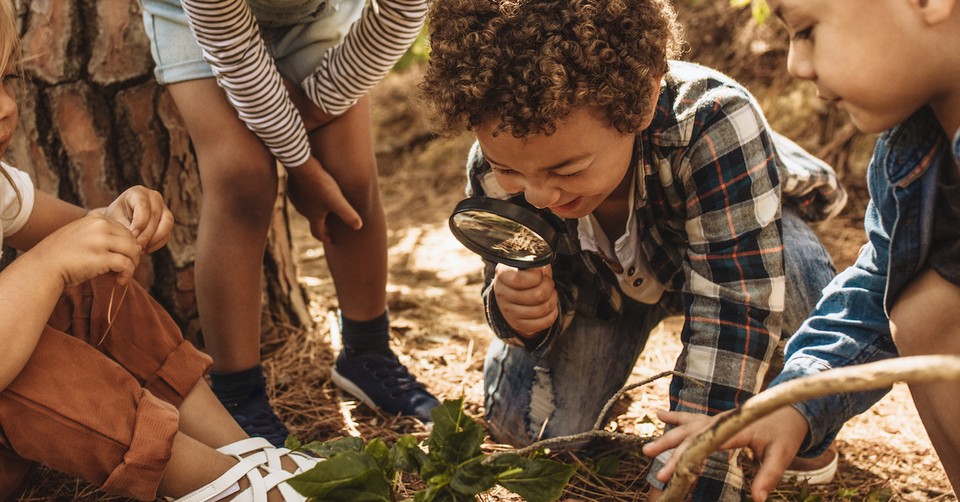Explore the World of Insects

Get Outside and Explore the World of Insects
Encouragement, good experiences, and a bit of equipment all foster the natural interests of a budding entomologist (one who studies insects). With about two billion insects for every human being, and many insects still waiting to be identified, a junior entomologist has a wonderful world to explore!
Our daughter, eight years old at the time, was inspired to learn everything that she could about crickets after reading A Cricket in Times Square by George Seldon. Little did we know that this one great book would lead our whole family to seek opportunities to learn about insects.
Encouragement
Whether you get excited about insects yourself or see them more as creepy-crawly six-legged pests, take time to get excited with your insect-enthralled child. Listen to them describe the "cool" insect they found; help them find books and people to learn more from; encourage them to draw or display their findings to share with others; and go ahead—hold a Madagascar hissing cockroach!
Explore and Equip
Some of our favorite places to search for insects are ponds, wooded areas, and prairies at the various conservation areas and parks close to us. Ponds are a wonderful habitat to find several stages of insects, such as dragonflies. Many insects make forests and prairies their home, including beetles, grasshoppers, katydids, butterflies, and so many more. Nighttime is perfect for studying moths and fireflies—shining a flashlight on a white sheet attracts many nighttime insects. Before you go on your insect adventure, take time to learn about the insects you may encounter in the area.
A little preparation and a small amount of equipment can turn a good insect-exploring experience into a great one. Fill your backpack with a notebook, drawing pad, pencils, a magnifying glass, and a field guide (see below for resources). Add some jars or small plastic containers for observing and collecting insects. Containers designed for observing insects typically have magnification in the lid. Plastic containers with compartments, like those you find with fishing tackle boxes, work well for collecting dead insect specimens to bring home. Now, grab some nets and a camera and get outside. Butterfly nets and small insect nets are useful in most habitats. Skimmer nets with a flat edge are great for catching aquatic insects.
While the focus of your adventure may be insects, take time to explore the other creatures and plant life in the area. God put them all together for a reason. Find out how they interact and what relationships you can identify.
Preserve and Display
Preserving and displaying the insects you find is a great way to record your findings. The basic equipment needed includes:
- a killing jar and ethyl acetate (if you want to collect live specimens to preserve)
- a case or jar with wet paper towels to relax (soften) insects that are hard or brittle
- a spreading board to position insects after softening
- pins (size 2 works best for most insects)
- labels
- a pinning block to position the labels
- a display case
We found our supplies, including a booklet that guides you through preserving and displaying insects, at Home Science Tools.
Experiences
Other wonderful experiences that we found for our budding entomologist included visiting the Iowa State University Department of Entomology. Here we were able to visit with an expert on aquatic insects, discuss career opportunities in entomology, see their incredible insect museum, and learn about some tools of the trade. If there is a college with an entomology department near you, I would highly recommend making a contact there and visiting their collection of insects.
Volunteering at a local conservation area, assisting at an insect program, and visiting with naturalists to exchange knowledge and experiences have all been great opportunities for our junior entomologist. Tagging monarch butterflies before they migrate south for the winter is one of our favorite events.
If you want to try raising insects, do your research first. Find out what they eat, how to care for them, and what they need for their different life stages. Whether you want to raise caterpillars to butterflies or watch a praying mantis egg case hatch, you'll be amazed at God's creation.
By diving into the world of insects with your kids, you may find, as I have, that these creatures are fascinating. Your junior entomologist may have a future career in entomology, or it may be a fun hobby; either way, you and your children will develop a deeper appreciation for the complexity, order, and variety in God's creation.
Resources for Insect Identification
- The Audubon Society Field Guide to North American Insects and Spiders by Milne and Milne
- Insects: Their Natural History and Diversity by Stephen A. Marshall
- Nick Baker's Bug Book
- www.insectidentification.org
- Free Apps: iNaturalist and Picture Insect–Bug Identifier
Careers in Entomology
- Agriculture
- Food and Health
- Pest Control
- Military
- Research
- Academic
- Department of Natural Resources
- Federal and State Regulatory Agencies
- Zoos, Botanical Gardens, Butterfly Houses
(A more detailed list can be found here)
Copyright 2022, The Old Schoolhouse®. Used with permission. All rights reserved by the Author. Originally appeared in the Spring 2022 issue of The Old Schoolhouse® Magazine, the trade publication for homeschool moms. Read The Old Schoolhouse® Magazine free at www.TOSMagazine.com, or download the free reader apps at www.TOSApps.com for mobile devices. Read the STORY of The Old Schoolhouse® Magazine and how it came to be.
Photo credit: ©GettyImages/jacoblund
Sarah Roth is a homeschooling mom of five children who loves to share good books, fun adventures, and many laughs. Prior to staying home to teach her children, she worked as a registered nurse and a small-animal veterinarian. When she is not teaching, caring for animals or people, or exploring the great outdoors with her family, Sarah loves to write, sing, and curl up with a cup of hot coffee and a good book.
Originally published April 08, 2022.







